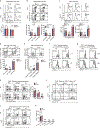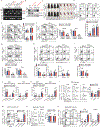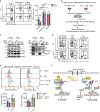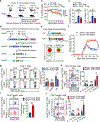AIM2 in regulatory T cells restrains autoimmune diseases
- PMID: 33505023
- PMCID: PMC8080937
- DOI: 10.1038/s41586-021-03231-w
AIM2 in regulatory T cells restrains autoimmune diseases
Erratum in
-
Author Correction: AIM2 in regulatory T cells restrains autoimmune diseases.Nature. 2021 Apr;592(7856):E29. doi: 10.1038/s41586-021-03490-7. Nature. 2021. PMID: 33854241 No abstract available.
-
Author Correction: AIM2 in regulatory T cells restrains autoimmune diseases.Nature. 2025 Dec;648(8092):E4. doi: 10.1038/s41586-025-09859-2. Nature. 2025. PMID: 41258132 No abstract available.
Abstract
The inflammasome initiates innate defence and inflammatory responses by activating caspase-1 and pyroptotic cell death in myeloid cells1,2. It consists of an innate immune receptor/sensor, pro-caspase-1, and a common adaptor molecule, ASC. Consistent with their pro-inflammatory function, caspase-1, ASC and the inflammasome component NLRP3 exacerbate autoimmunity during experimental autoimmune encephalomyelitis by enhancing the secretion of IL-1β and IL-18 in myeloid cells3-6. Here we show that the DNA-binding inflammasome receptor AIM27-10 has a T cell-intrinsic and inflammasome-independent role in the function of T regulatory (Treg) cells. AIM2 is highly expressed by both human and mouse Treg cells, is induced by TGFβ, and its promoter is occupied by transcription factors that are associated with Treg cells such as RUNX1, ETS1, BCL11B and CREB. RNA sequencing, biochemical and metabolic analyses demonstrated that AIM2 attenuates AKT phosphorylation, mTOR and MYC signalling, and glycolysis, but promotes oxidative phosphorylation of lipids in Treg cells. Mechanistically, AIM2 interacts with the RACK1-PP2A phosphatase complex to restrain AKT phosphorylation. Lineage-tracing analysis demonstrates that AIM2 promotes the stability of Treg cells during inflammation. Although AIM2 is generally accepted as an inflammasome effector in myeloid cells, our results demonstrate a T cell-intrinsic role of AIM2 in restraining autoimmunity by reducing AKT-mTOR signalling and altering immune metabolism to enhance the stability of Treg cells.
Figures














References
Extended References:
Publication types
MeSH terms
Substances
Grants and funding
- R01 CA156330/CA/NCI NIH HHS/United States
- P01 DK094779/DK/NIDDK NIH HHS/United States
- R01 AI160774/AI/NIAID NIH HHS/United States
- R56 AI029564/AI/NIAID NIH HHS/United States
- P30 CA016086/CA/NCI NIH HHS/United States
- R01 AI097392/AI/NIAID NIH HHS/United States
- R01 AI123193/AI/NIAID NIH HHS/United States
- U19 AI067798/AI/NIAID NIH HHS/United States
- R01 NS107851/NS/NINDS NIH HHS/United States
- R37 AI029564/AI/NIAID NIH HHS/United States
- R01 AI029564/AI/NIAID NIH HHS/United States
- R01 DK119445/DK/NIDDK NIH HHS/United States
LinkOut - more resources
Full Text Sources
Other Literature Sources
Molecular Biology Databases
Miscellaneous

